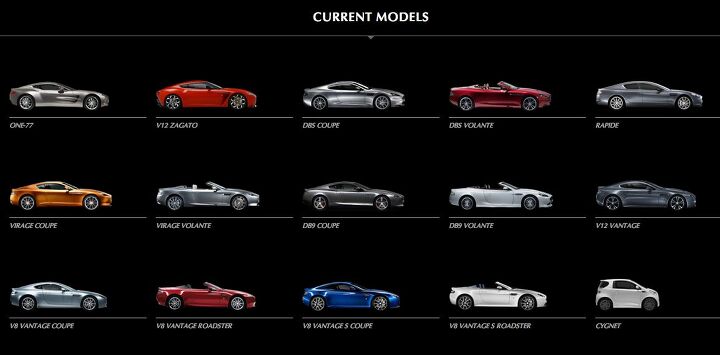Ask The Best And Brightest: Is Aston-Martin A Bit Old Hat?
Ian Callum, designer of the Aston-Martin DB7 (along with the new Jaguars and numerous other gorgeous things) is a really, genuinely nice guy. But even nice guys have their limits, and having seen his groundbreaking Aston design evolve with the morphological dynamism of a sturgeon over the last 17 years, Callum appears to have reached his. Bloomberg reports:
It’s still that same old basic design,” Ian McCallum, who designed the DB9 and is now design director at Tata Motors Ltd. (TTMT)’s Jaguar Land Rover unit, said in a July 27 interview. “Some will argue that if it ain’t broke, don’t fix it. But you do get to a time when you have to move on.”
Sadly, there are a few factual distractions to deal with here before we dig further into Aston’s predicament. First of all, though a Scot, the man’s name is Callum, not McCallum. Also, it’s not clear how much of the DB9 was styled by Callum, and how much was finished by his successor, Heinrik Fisker. Clear? OK, back to Aston…
The models are starting to have a slight whiff of Sunday dinner being used in sandwiches later in the week. It leaves the impression of a company stretching itself as far as it can. In the industry that they operate in, with their competitors, they really need to be cutting edge.
The stuck-in-time, across-the-line styling is part of the problem. A platform that was the talk of the enthusiast committee in 2003 is the other part. A resurgent, Callum-designed Jaguar lineup doesn’t help. Plus, split-the-difference “new” models certainly don’t mask the scent of death well, nor do Toyota rebadges. The prosecution rests.
And what of the defense? Well, all Astons may look the same and be technologically outdated, but they’re still pretty damn good looking. Also,
“All the projects that we are doing have to make a profit,” Chief Executive Officer Ulrich Bez, 66, told journalists at the company’s Gaydon headquarters. “We can’t afford a project that is just a marketing tool.”
The strategy has pushed up the average price of Aston Martin cars 49 percent to 104,000 pounds last year from 70,000 pounds in 2007, the company said at the July 6 briefing.
By recycling technology and using engines from Ford, Aston Martin can keep costs and development times down. That’s secured Aston Martin a profit margin of about 20 percent, nearly double Mercedes’s 10.7 percent return on sales in the second quarter.
Twice the profit margin of Mercedes? That’s nice, but how long will it last when
Daimler AG (DAI), the parent of Mercedes-Benz, plans to spend about 5 billion euros ($7.1 billion) this year on research and development. That’s more than eight times the Gaydon, England-based company’s revenue of 509 million pounds ($830 million) for the 12 months ended March 31.[?]
The sad irony of Aston’s flirtation with over-the-hill, passé status is that it still hasn’t held an IPO, but is waiting for “the right window” (i.e. when the market comes back). By the time that happens, could it be too late for the last independent global British sportscar brand?
More by Edward Niedermeyer
Latest Car Reviews
Read moreLatest Product Reviews
Read moreRecent Comments
- Pig_Iron This message is for Matthew Guy. I just want to say thank you for the photo article titled Tailgate Party: Ford Talks Truck Innovations. It was really interesting. I did not see on the home page and almost would have missed it. I think it should be posted like Corey's Cadillac series. 🙂
- Analoggrotto Hyundai GDI engines do not require such pathetic bandaids.
- Slavuta They rounded the back, which I don't like. And inside I don't like oval shapes
- Analoggrotto Great Value Seventy : The best vehicle in it's class has just taken an incremental quantum leap towards cosmic perfection. Just like it's great forebear, the Pony Coupe of 1979 which invented the sportscar wedge shape and was copied by the Mercedes C111, this Genesis was copied by Lexus back in 1998 for the RX, and again by BMW in the year of 1999 for the X5, remember the M Class from the Jurassic Park movie? Well it too is a copy of some Hyundai luxury vehicles. But here today you can see that the de facto #1 luxury SUV in the industry remains at the top, the envy of every drawing board, and pentagon data analyst as a pure statement of the finest automotive design. Come on down to your local Genesis dealership today and experience acronymic affluence like never before.
- SCE to AUX Figure 160 miles EPA if it came here, minus the usual deductions.It would be a dud in the US market.


































Comments
Join the conversation
The DB9 and V8 vantage are sculpture with a soundtrack. I can see why they're doing what they're doing, after all how many 911 variants are there? It is as close to my perfect vehicle as exists (I use the nav on my phone anyways).
Yeah, Callum was heavily involved with the DB7, but it is grossly unfair to Keith Helfet to suggest that it was Callum's design. http://www.aronline.co.uk/blogs/2011/07/23/concepts-and-prototypes-jaguar-xj4142/